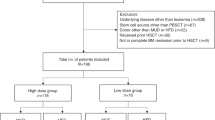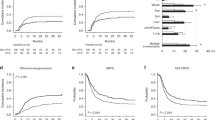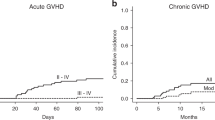Summary:
Antilymphocyte/thymocyte globulins (ALGs/ATGs) have now been used for over 30 years in the setting of hemopoietic stem cell transplants (HSCT), with the aim of preventing graft-versus-host disease (GvHD). This is true especially for transplants from alternative donors. In this review, we will be discussing available published and unpublished data on the advantages and disadvantages of using ALG/ATG before or after an allogeneic HSCT. These studies show that ALG/ATG significantly reduce the incidence and severity of acute and chronic GvHD. Unfortunately, they also show that immune deficiency is a more prolonged and infectious complication more frequent in patients receiving ALG/ATG, suggesting the importance of aggressive monitoring of viral and fungal infections. In particular, the emerging problem of Epstein–Barr virus (EBV) infections and EBV-related lymphoproliferative disorders will be discussed, together with the use of pre-emptive therapy with rituximab. I personally believe ALG/ATG has an important role in allogeneic HSCT, especially today with the increasing use of peripheral blood transplants and the consequent high risk of chronic GvHD. ALG/ATG should be used with caution, and the negative consequences must be understood and possibly prevented.
This is a preview of subscription content, access via your institution
Access options
Subscribe to this journal
Receive 12 print issues and online access
$259.00 per year
only $21.58 per issue
Buy this article
- Purchase on Springer Link
- Instant access to full article PDF
Prices may be subject to local taxes which are calculated during checkout

Similar content being viewed by others
References
Gratwohl A, Hermans J, Apperley J, et al, for the Working Party Chronic Leukemia of the European Group for Blood and Marrow Transplantation. Acute graft-versus-host-disease: grade and outcome in patients with chronic myelogenous leukemia. Blood 1995; 86: 813–818.
Lee SJ, Vogelsang G, Gilman A et al. A survey of diagnosis, management and grading of chronic GVHD. Biol Blood Marrow Transplant 2002; 8: 32–39.
Goerner M, Gooley T, Flowers ME et al. Morbidity and mortality of chronic GVHD after hematopoietic stem cell transplantation from HLA-identical siblings for patients with aplastic or refractory anemias. Biol Blood Marrow Transplant 2002; 8: 47–56.
Van Lint MT, Uderzo C, Locasciulli A, et al, for the Italian Group of Bone Marrow Transplantation (GITMO). Early treatment of acute graft-versus-host disease with high-or low-dose 6-methylprednisolone: a multicenter randomized trial from the Italian Group for Bone Marrow Transplantation. Blood 1998; 92: 2288–2293.
Koc S, Leisenring W, Flowers ME et al. Therapy for chronic graft-versus-host disease: a randomized trial comparing cyclosporine plus prednisone vs prednisone alone. Blood 2002; 100: 48–51.
Marmont AM, Horowitz MM, Gale RP et al. T-cell depletion of HLA-identical transplants in leukemia. Blood 1991; 78: 2120–2130.
Hows J, Bradley B, Gore S et al. Prospective evaluation of unrelated donor bone marrow transplantation. Bone Marrow Transplant 1993; 12: 371–380.
Nash RA, Antin JH, Karanes C et al. Phase 3 study comparing methotrexate and tacrolimus with methotrexate and cyclosporine for prophylaxis of acute graft versus-host disease after marrow transplantation from unrelated donors. Blood 2000; 96: 2062–2068.
Weisdorf DJ, Anasetti C, Antin JH et al. Allogeneic bone marrow transplantation for chronic myelogenous leukemia: comparative analysis of unrelated vs matched sibling donor transplantation. Blood 2002; 99: 1971–1977.
Marks DI, Cullis JO, Ward KN et al. Allogeneic bone marrow transplantation for chronic myeliod leukemia using siblings and volunteer unrelated donors. A comparison in complication in the first 2 years. Ann Intern Med 1993; 119: 204–214.
Schwarzenberg L, Mathe G . Treatment of bone marrow aplasias by bone marrow graft in patients lacking compatible donors. Preparation by anti-lymphocyte globulin (ALG). Long-term results. Ann Med Interne (Paris) 1977; 128: 441–444.
Speck B, Buckner CD, Cornu P, Jeannet B . Rationale for the use of ALG as sole immunosuppressant in allogeneic bone marrow transplantation for aplastic anemia. Transplant Proc 1976; 8: 617–622.
EBMT Annual Meeting. Bone Marrow Transplant 2004; 33 (Suppl 1).
Van Lint MT, Uderzo C, Milone G, et al, for Gruppo Trapianto di Midollo Osseo (GITMO). A GITMO randomized trial in steroid refractory acute graft vs host disease: 6 methylprednisolone with or without anti-thymocyte globulin. Bone Marrow Transplant 2004; 33 (Suppl 1): 545.
Weiden PL, Doney K, Storb R, Thomas ED . Antihuman thymocyte globulin for prophylaxis of graft-versus-host disease. A randomized trial in patients with leukemia treated with HLA-identical sibling marrow grafts. Transplantation 1979; 27: 227–230.
Ramsay NKC, Kersey JH, Robinson LL et al. A randomized study of the prevention of acute graft versus host disease. N Engl J Med 1982; 306: 392–397.
Bacigalupo A, Lamparelli T, Bruzzi P et al. Antithymocyte globulin for graft-versus-host disease prophylaxis in transplants from unrelated donors: 2 randomized studies from Gruppo Italiano Trapianti Midollo Osseo (GITMO). Blood 2001; 98: 2942–2947.
Baurmann H, Bonnefoy-Bérard N, Thiede C et al. Clinical and biological effects of ATG used as part of the conditioning in matched unrelated donor (MUD) transplantation. Blood 1999; 94 (Suppl 1, Part 1): 134a.
Holler E, Ledderose G, Knabe H . ATG serotherapy during pre-transplant conditioning in unrelated donor BMT: dose-dependent modulation of GVHD. Bone Marrow Transplant 1998; 21 (Suppl 1): 105a.
Byrne JL, Stainer C, Cull G, Haynes AP . The effect of the serotherapy regimen used and the marrow cell dose received on rejection, graft-versus-host disease and outcome following unrelated donor bone marrow transplantation for leukaemia. Bone Marrow Transplant 2000; 25: 411–417.
Finke J, Bertz H, Schmoor C et al. Allogeneic bone marrow transplantation from unrelated donors using in vivo anti-T-cell globulin. Br J Haematol 2000; 111: 303–313.
Zander AR, Zabelina T, Kroger N et al. Use of a five-agent GvHD prevention regimen in recipients of unrelated donor marrow. Bone Marrow Transplant 1999; 23: 889–893.
Remberger M, Storer B, Ringden O, Anasetti C . Matched cohort study finds that thymoglobulin might decrease non-relapse mortality after marrow transplantation from unrelated donors. Blood 2000; 96: 391a.
Basara N, Yaman A, Kolbe K et al. Anti-thymocyte globulin in unrelated hematopoietic stem cell transplantation for acute myeloid leukemia: multicentre German Cooperative Study Group. Bone Marrow Transplant 2004; 33: S69.
Kroger N, Zabelina T, Kruger W et al. In vivo T cell depletion with re-transplant anti-thymocyte globulin reduces graft vs host disease, without increasing relapse in good risk myeloid leukemia patients after stem cell transplantation from matched related donors. Bone Marrow Transplant 2002; 29: 683–689.
Duggan P, Booth K, Chaudhry A et al. Alberta Blood and Bone Marrow Transplant Program. Unrelated donor BMT recipients given pretransplant low-dose antithymocyte globulin have outcomes equivalent to matched sibling BMT: a matched pair analysis. Bone Marrow Transplant 2002; 30: 681–686.
Schleuning M, Kaltenhauser J, Heshmat M et al. The influence of ATG source on the outcome after unrelated transplants for chronic phase CML – a single-centre experience. Bone Marrow Transplant 2004; 33: O357.
Bacigalupo A, Lamparelli T, Gualandi F et al. Prophylactic antithymocyte globulin reduces the risk of chronic graft-versus-host disease in alternative-donor bone marrow transplants. Biol Blood Marrow Transplant 2002; 8: 656–661.
Zander AR, Kroger N, Schleuning M et al. ATG as part of the conditioning regimen reduces transplant related mortality (TRM) and improves overall survival after unrelated stem cell transplantation in patients with chronic meyloid leukemia. Bone Marrow Transplant 2003; 32: 355–361.
Bonifazi F, Bandini G, Falcioni S et al. Low dose rabbit ATG prevents GvHD in sibling allogeneic peripheral blood stem cell transplantation. Bone Marrow Transplant 2004; 33 (Suppl 1): s311.
Dominietto A, Van Lint MT, Gualandi F et al. Is timing of anti-thymocyte globulin (ATG) – pre and post hemopoietic stem cell transplants (HSCT) – relevant for graft vs host disease (GvHD)? Blood 2003; 102: 242a (abstr 851).
Mohty M, Bay JO, Faucher C et al. Graft-versus-host disease following allogeneic transplantation from HLA-identical sibling with antithymocyte globulin-based reduced-intensity preparative regimen. Blood 2003; 102: 470–476.
Meijer E, Cornelissen JJ, Lowenberg B, Verdonck LF . Antithymocyteglobulin as prophylaxis of graft failure and graft-versus-host disease in recipients of partially T-cell-depleted grafts from matched unrelated donors: a dose-finding study. Exp Hematol 2003; 31: 1026–1030.
Schleuning M, Gunther W, Tischer J et al. Dose-dependent effects of in vivo antithymocyte globulin during conditioning for allogeneic bone marrow transplantation from unrelated donors in patients with chronic phase CML. Bone Marrow Transplant 2003; 32: 243–250.
Waller EK, Langston AA, Lonial S et al. Pharmacokinetics and pharmacodynamics of anti-thymocyte globulin in recipients of partially HLA-matched blood hematopoietic progenitor cell transplantation. Biol Blood Marrow Transplant 2003; 9: 460–471.
Saito T, Kanda Y, Nakai K et al. Immune reconstitution following reduced-intensity transplantation with cladribine, busulfan, and antithymocyte globulin: serial comparison with conventional myeloablative transplantation. Bone Marrow Transplant 2003; 32: 601–608.
Nakai K, Mineishi S, Kami M et al. Antithymocyte globulin affects the occurrence of acute and chronic graft-versus-host disease after a reduced-intensity conditioning regimen by modulating mixed chimerism induction and immune reconstitution. Transplantation 2003; 75: 2135–2143.
Kalwak K, Moson I, Cwian J et al. A prospective analysis of immune recovery in children following allogeneic transplantation of t-cell-depleted or non-T-cell-depleted hematopoietic cells from HLA-disparate family donors. Transplant Proc 2003; 35: 1551–1555.
Meijer E, Bloem AC, Dekker AW, Verdonck LF . Effect of antithymocyte globulin on quantitative immune recovery and graft-versus-host disease after partially T-cell-depleted bone marrow transplantation: a comparison between recipients of matched related and matched unrelated donor grafts. Transplantation 2003; 75: 1910–1913.
Fehse N, Fehse B, Kroger N et al. Influence of anti-thymocyte globulin as part of the conditioning regimen on immune reconstitution following matched related bone marrow transplantation. J Hematother Stem Cell Res 2003; 12: 237–242.
Thomson BG, Robertson KA, Gowan D et al. Analysis of engraftment, graft-versus-host disease, and immune recovery following unrelated donor cord blood transplantation. Blood 2000; 96: 2703–2711.
Baumann H, Judith D, Zey C et al. Antithymocyte globulin Fresenius or San gstat (Genzyme) as part of the conditioning for unrelated donor HSCT: emerging differences in post-transplant immune reconstitution. Bone Marrow Transplant 2004; 33: S51.
Van Esser JW, van der Holt B, Meijer E et al.; Epstein–Barr virus (EBV) reactivation is a frequent event after allogeneic stem cell transplantation (SCT) and qualitatively predicts EBV-lymphoproliferative disease following T cell depleted SCT. Blood 2001; 98: 972–978.
Dominietto A, Tedone E, Soracco M et al. Epstein–Barr virus reactivation after allogeneic hematopoietic stem cell transplant based on molecular monitoring is predictive of lymphoproliferative disease. Bone Marrow Transplant 2004; 33: S192.
Bacigalupo A . Second EBMT Workshop on reduced intensity allogeneic hemopoietic stem cell transplants (RI-HSCT). Bone Marrow Transplant 2002; 29: 191–195.
Storb R, Yu C, Sanmeier BM et al. A Mixed hemopoietic chimerism after marrow allografts. Transplantation in the ambulatory care setting. Ann NY Acad Sci 1999; 872: 372–375.
Slavin S, Nagler A, Naparstek E et al. Nonmyeloablative stem cell transplantation and cell therapy as an alternative to conventional bone marrow transplantation with lethal cytoreduction for the treatment of malignant and nonmalignant hematologic diseases. Blood 1998; 91: 756–763.
Raiola AM, Van Lint MT, Lamparelli T et al. Reduced intensity thiotepa-cyclophosphamide conditioning for allogeneic haemopoietic stem cell transplants (HSCT) in patients up to 60 years of age. Br J Haematol 2000; 109: 716–721.
Kottaridis PD, Chakravety R, Milligan DW et al. A non-myeloablative regimen for allogeneic stem cell transplantation with a low incidence of GVHD. Bone Marrow Transplant 2000; 25: S26.
Kroger N, Sayer HG, Schwerdtfeger R et al. Unrelated stem cell transplantation in multiple myeloma after a reduced-intensity conditioning with pretransplantation antithymocyte globulin is highly effective with low transplantation-related mortality. Blood 2002; 100: 3919–3924.
Schleuning M, Kaltenhauser J, Heshmat M et al. The influence of ATG source on the outcome after unrelated transplants for chronic phase CML – a single center experience. Bone Marrow Transplant 2004; 33: S62.
Urbano-Ispizua A, Schmitz N, de Witte T, et al, for the European Group for Blood and Marrow Transplantation. Allogeneic and autologous transplantation for haematological diseases, solid tumours and immune disorders: definitions and current practice in Europe. Bone Marrow Transplant 2002; 29: 639–646.
Schmitz N, Beksac M, Hasenclever D, et al, for the European Group for Blood and Marrow Transplantation. Transplantation of mobilized peripheral blood cells to HLA identical siblings with standard risk leukaemia. Blood 2002; 100: 761–767, Blood 1998; 91: 756–763.
Author information
Authors and Affiliations
Corresponding author
Rights and permissions
About this article
Cite this article
Bacigalupo, A. Antilymphocyte/thymocyte globulin for graft versus host disease prophylaxis: efficacy and side effects. Bone Marrow Transplant 35, 225–231 (2005). https://doi.org/10.1038/sj.bmt.1704758
Published:
Issue Date:
DOI: https://doi.org/10.1038/sj.bmt.1704758
Keywords
This article is cited by
-
Higher cyclosporine-A concentration increases the risk of relapse in AML following allogeneic stem cell transplantation from unrelated donors using anti-thymocyte globulin
Scientific Reports (2023)
-
Efficacy of low dose antithymocyte globulin on overall survival, relapse rate, and infectious complications following allogeneic peripheral blood stem cell transplantation for leukemia in children
Bone Marrow Transplantation (2021)
-
Implications of hematopoietic stem cells heterogeneity for gene therapies
Gene Therapy (2021)
-
Combination of double negative T cells and anti-thymocyte serum reverses type 1 diabetes in NOD mice
Journal of Translational Medicine (2016)
-
HLA Disparity is not crucial for the survival rate and severity of chronic health conditions in adult recipients following family donor hematopoietic stem cell transplantation
International Journal of Hematology (2015)



